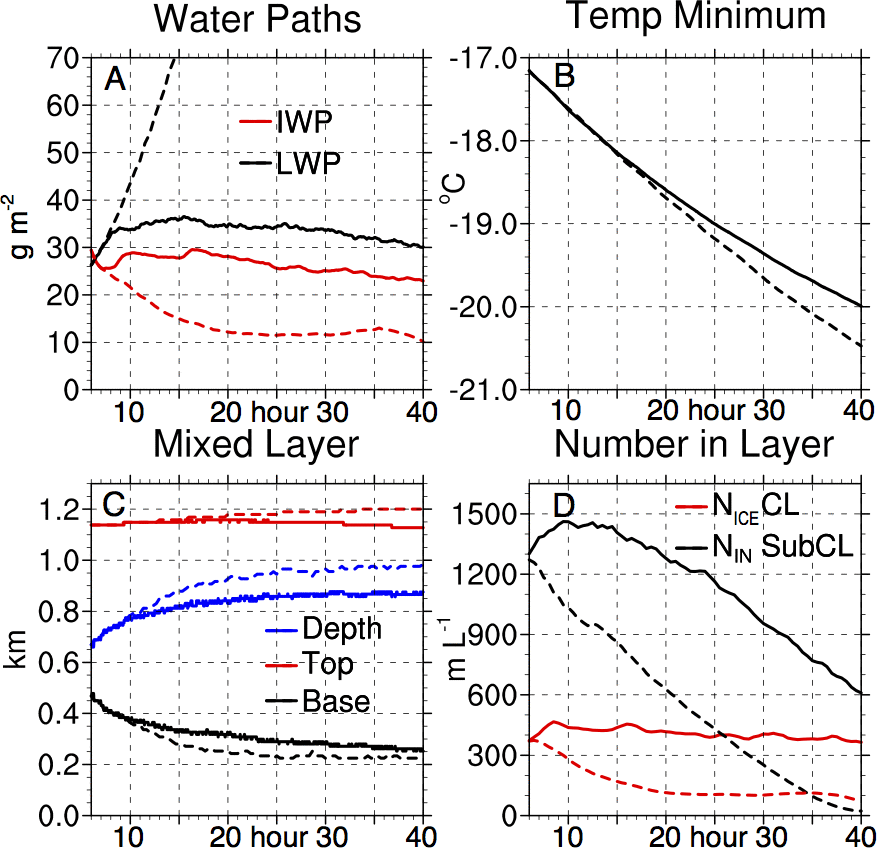The role of ice nuclei recycling in the maintenance of cloud ice in arctic mixed-phase stratocumulus
Submitter:
Solomon, Amy — University of Colorado/NOAA- Earth System Research Laboratory
Feingold, Graham — NOAA Earth System Research Laboratory
Area of research:
Cloud-Aerosol-Precipitation Interactions
Journal Reference:
Science
In this study, we use large-eddy simulations that include a prognostic ice nuclei formulation and a diurnal cycle to investigate the maintenance of cloud ice in Arctic mixed-phase stratocumulus (AMPS) by the recycling of ice nuclei in regions of ice subsaturation. AMPS frequently have ice-subsaturated air near the cloud-driven mixed-layer base where falling ice crystals can sublimate, leaving behind ice nuclei. This feedback loop is referred to as "recycling."
This study focuses on the internal microphysics and dynamics of the cloud-driven mixed layer by investigating processes in an AMPS decoupled from surface sources of moisture, heat, and ice nuclei. The case derives from observations of a persistent single-layer AMPS cloud observed on April 8, 2008, near Barrow, Alaska, during the Indirect and Semi-Direct Aerosol Campaign (McFarquhar et al. 2011). All model runs are initialized with wind, temperature, and water vapor from the 17Z April 8, 2008, sounding at Barrow. We adopt an empirical approach by initializing ice nuclei number concentration with an observationally based relationship that expresses the number of available ice nuclei as a function of temperature in regions of water saturation (DeMott et al. 2010). Sixteen prognostic equations are integrated for ice nuclei number concentration in equally spaced temperature intervals with nucleation thresholds between 20.2 and 15.5°C. Therefore, additional ice nuclei become available for activation with decreasing temperature and as the cloud layer cools.
Impact
In the control simulation with recycling included but without a diurnal cycle, ice nuclei are produced by sublimation of ice crystals below the cloud layer, advected to the cloud layer by turbulence, and activated as ice crystals. Ice that forms in the cloud layer is transported vertically by turbulence, precipitates to the cloud base, and then to below the cloud layer where it sublimates. At the mixed-layer base, an increase in ice nuclei number concentration due to precipitation approximately balances a decrease in ice nuclei number concentration due to sublimation. These processes constitute a feedback through which ice production and ice nuclei recycling are closely related. This feedback between ice production and ice nuclei in the mixed layer is linked to dynamic–thermodynamic tendencies that sustain a subsaturated subcloud layer because the decrease in relative humidity caused by an upward turbulent vapor flux exceeds the increase due to sublimation.
When recycling is turned off, all ice nuclei that activate are lost from the system, resulting in a more rapid loss of ice nuclei, a decrease in ice water path, and a rapid increase in liquid water path. This finding is in contrast to the measurements that show a steady liquid layer and consistent ice production (see Figure 1). The increased cloud liquid water that is observed when recycling is turned off results in increased radiative cooling at the cloud top, which causes the cloud-driven mixed layer to cool more rapidly. The rapid increase in the liquid water path increases cloud-generated turbulence via enhanced radiative cooling and increases the turbulent mixing of ice nuclei from the subcloud layer into the cloud layer, contributing to a more rapid depletion of ice nuclei relative to the control integration.
Allowing for a diurnal cycle slows the loss of ice nuclei from the cloud-driven mixed layer. When incoming shortwave radiation is a maximum, recycling (sublimation) is seen to be at a minimum (see Figure 2). However, because of weak turbulent mixing between the cloud and subcloud layers, the net flux of ice crystals into the subcloud layer is weak, resulting in weak sublimation and recycling. When incoming shortwave radiation is a minimum, more ice nuclei are activated because the cloud layer cools. However, the ice nuclei number tendencies due to thermodynamics are buffered by the slowing of turbulence-driven feedback because of a thickening of the cloud layer. Thus, a net increase in ice nuclei in the cloud layer, commensurate with an increased ice water path and precipitation, is buffered by a decrease in the downward turbulent mixing of ice nuclei, which reduces recycling, thus slowing the feedback loop.
Summary
This model study demonstrates that sustained recycling of ice nuclei through a drying subcloud layer and additional activation due to a cooling cloud layer are sufficient to maintain ice production and that these processes regulate liquid production over multiple days in a decoupled AMPS. In addition, this study shows that modulation of the cooling of the cloud layer and the humidity of the subcloud layer by the diurnal cycle buffers the mixed-layer system from a loss of particles and promotes the persistence of a mixed-phase cloud system.



